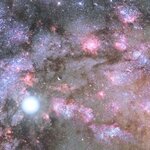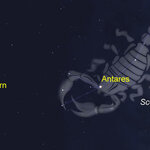Space

There are some massive galaxies out there, and we now know a little about their early life.Credit: Lauro Roger McAllister/Flickr, CC BY
By Edward Taylor, University of Melbourne
A piece of the galaxy formation puzzle may have fallen into place, thanks to a team of European and American astronomers peering into the depths of our early universe.
According to new research published in Nature, the galaxy GOODS-N-227 might show us how the most massive galaxies are formed – and why it’s been so hard to find them before now.
As it takes time for light to travel great distances, looking at the most…

Astronomers have caught a glimpse of the earliest stages of massive galaxy construction - a dense galactic core blazing with the light of millions of newborn stars that are forming at a ferocious rate.
A fully developed elliptical galaxy is a gas-deficient gathering of ancient stars theorized to develop from the inside out, with a compact core marking its beginnings. Because the galactic core is so far away, the light of the forming galaxy that is observable from Earth was actually created 11 billion years ago, just 3 billion years after the Big Bang.
Although only a fraction of the size of…

Where should we go, on Mars, to look for droplets and streaks of present day liquid water? You may have heard of the "warm seasonal flows", and the recent "swimming pools of bacteria".
However, there are several other promising ideas for habitats such as the "Flow like features", the advancing sand dunes bioreactor, and possibilities for life using the humidity of the night time air on Mars. It's an exciting field with many new discoveries and ideas every year, and it is hard to keep up with the developments.
Let's start with the Flow Like Features. These are less well known than…

New simulations hope to uncover the origin of the ultraviolet light that bathes the cosmos, helping scientists understand how galaxies were built.
"Which produces more light? A country's biggest cities or its many tiny towns?" asks Dr. Andrew Pontzen, University College London cosmologist and lead author of the study. "Cities are brighter, but towns are far more numerous. Understanding the balance would tell you something about the organisation of the country. We're posing a similar question about the universe: does ultraviolet light come from numerous but faint galaxies, or from a…
This is an exciting field which developed over just the last six years or so. There are many academic papers - but I haven't been able to find a good overview of the field in non technical language. So, let's do that. I'm drawing heavily on Nilton Renno's technical overview from last year, together with more recent results.
Let's start with the Flow Like Features associated with the dark dune spots in the southern polar region. These are lesswell known than some of the other candidates but rather interesting, as the best explanation involves melt water at 0°C, warm for liquid water on Mars,…

New research may help to solve the mystery of what caused a spectacular supernova in galaxy M82 11 million light years away.
The supernova, a giant explosion of a star and the closest one to the Earth in decades, was discovered earlier this year and new research into its cause used vast networks of radio telescopes in the UK and across Europe including the seven telescopes of e-MERLIN operated from The University of Manchester's Jodrell Bank Observatory. These enabled them to obtain extremely deep images revealing a lack of radio emission from the supernova.
Known as 2014J, this was a Type…

Across Australia, catch Mars and Saturn around 8 pm local time.Source: Museum Victoria/Stellarium
By Tanya Hill, Museum Victoria
Look up at the night sky this week and you’ll find Mars and Saturn together in the west. Mars stands out with its reddish colouring and you might just be able to detect a faint yellow tinge to Saturn.
The two planets have been slowly drifting towards each other and now Mars makes its dash to move past Saturn.
Towards the north is Scorpius, a dominant feature of our winter sky and an easy constellation to recognise with its hook-shaped tail and bright red…

NASA proposes to return a sample from Mars in the 1920s and recently announced details of the successor for Curiosity which will drill and cache samples for return. But is this the best approach in the search for life on Mars? What about searching "in situ" directly on Mars itself?
I only know of one comparison study of the two approaches, a white paper by eight exobiologists submitted to the decadal review. It came out strongly in favour of in situ research.
They saw the NASA plans as a "technology demo", likely to return results as ambiguous for the search for life as the Mars meteorites we…

A new captured by the Wide Field Imager at ESO’s La Silla Observatory in Chile shows two dramatic star formation regions in the southern Milky Way. On the left is the star cluster NGC 3603, located 20,000 light-years away in the Carina–Sagittarius spiral arm of the Milky Way galaxy. On the right, about half as far from Earth, is a collection of glowing gas clouds known as NGC 3576.
Both were discovered by English astronomer John Herschel in 1834, during his three-year expedition to systematically survey the southern skies from near Cape Town. He described NGC 3603 as a remarkable object…

The Hypatia Catalog is the largest catalog ever produced for stellar compositions and seeks to help in understanding the properties of stars, how they form, and possible connections with orbiting planets.
Named after one of the first female astronomers, who lived ~350 A.D. in Alexandria, the digital catalog is a compilation of spectroscopic abundance data from 84 literature sources for 50 elements across 3,058 stars in the solar neighborhood, within 500 light years of the Sun. It essentially lists the compositions of stars, but only stars that are like the Sun – or F-, G-, or K-type (the Sun…